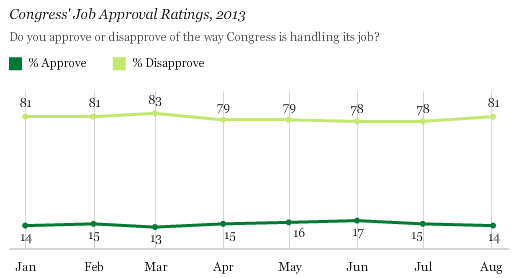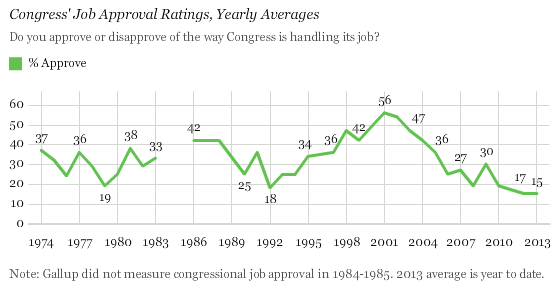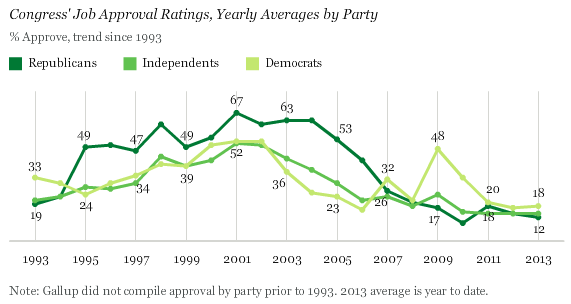PRINCETON, NJ -- Fourteen percent of Americans now approve of Congress and 81% disapprove. Americans' views of Congress have been highly stable, and highly negative, throughout the year.

Congress approval has averaged 15% thus far in 2013, on pace to tie 2012 as the lowest yearly average since Gallup began asking Americans to rate Congress' performance in 1974. Although the full 2012 and 2013 to-date yearly averages are the same, Americans' views of Congress were more variable last year, ranging from lows of 10% in February and August to a high of 21% in October.
Congress is well on its way to averaging below 20% approval for the fourth year in a row, and for the fifth year in the last six. The exception was 2009. That year, newly elected President Barack Obama was working with a large Democratic majority, which resulted in high approval among Democratic identifiers. Prior to 2008, Congress had averaged below 20% approval in only two of the 31 years for which Gallup had data, 1979 and 1992.

Divided Control of Congress Contributing to Lower Approval
A key factor contributing to Congress' lower ratings is divided party control of Congress, with the Republicans having a majority in the House of Representatives and Democrats with a majority of Senate seats. Neither Republicans nor Democrats in the general public have a strong sense of party loyalty to the current divided Congress, with 13% of Republicans and 17% of Democrats approving in the Aug. 7-11 poll. Party control of Congress has been divided since 2011.
In years when one party had control of both houses of Congress, that party's supporters gave Congress higher job ratings. This helped increase Congress' overall approval rating. Specifically, Democrats rated Congress more favorably than Republicans in 1993-1994 and 2007-2010, and Republicans gave Congress higher approval ratings than Democrats in 1995-2006.

But there is evidence that the divided Congress' recent low ratings reflect more than an absence of party loyalty. Notably, Democrats' average annual ratings of Congress since 2011 have been lower than their ratings in 11 of the 12 years in which Republicans had control of both houses. The exception was 2006, the year Democrats regained majority control in that year's midterm elections, when 16% of Democrats approved of Congress.
Likewise, Republicans' ratings of Congress during the last two years are lower than in most of the years in which Democrats held control of both houses since 1993. The exception was 2010, when President Obama signed the Affordable Care Act into law and Republicans subsequently took back control of the House in that year's midterm elections.
Thus, Republicans and Democrats alike may have additional reasons to be discouraged by the work Congress is doing. Two likely reasons are the sluggish economy and Congress' seeming inability to address the major problems facing the country, including the economy, the budget deficit and federal spending, and gun control.
Implications
Americans' ratings of Congress remain near historical lows, with 14% approving of the job it is doing. Congress is currently in recess, and although it did take action before its members left Washington to address the increase in student loan interest rates, it faces significant challenges when it returns in September. These include trying to reach agreement on a budget for the new fiscal year, raising the federal debt limit, and reaching agreement on immigration reform.
If Congress is able to successfully reach agreement on those types of issues, the public may begin to see it in a more favorable light. However, fiscal issues like government spending and the deficit have been among the most contentious for Congress and are issues they have been unable to reach agreement on. For example, the failure of the federal deficit "supercommittee" to agree on deficit-reduction measures led to the budget sequester in effect today.
Next year is a congressional election year, and all House seats and roughly one-third of Senate seats will be up for election. When Congress is unpopular, that typically leads to more turnover of seats in Congress, as in 1994, 2006, and 2010. However, with control of Congress divided between the two parties, it is harder for voters to assign blame and thus give control of Congress to the minority party, as occurred in those other elections. Additionally, Americans are much more positive about their own member of Congress, and are able to vote for or against only that member. Thus, despite Americans' frustrations with the institution, it is unclear whether the 2014 elections will bring about major change in Congress.
Survey Methods
Results for this Gallup poll are based on telephone interviews conducted Aug. 7-11, 2013, with a random sample of 2,059 adults, aged 18 and older, living in all 50 U.S. states and the District of Columbia.
For results based on the total sample of national adults, one can say with 95% confidence that the margin of sampling error is ±3 percentage points.
Interviews are conducted with respondents on landline telephones and cellular phones, with interviews conducted in Spanish for respondents who are primarily Spanish-speaking. Each sample of national adults includes a minimum quota of 50% cellphone respondents and 50% landline respondents, with additional minimum quotas by region. Landline and cell telephone numbers are selected using random-digit-dial methods. Landline respondents are chosen at random within each household on the basis of which member had the most recent birthday.
Samples are weighted to correct for unequal selection probability, nonresponse, and double coverage of landline and cell users in the two sampling frames. They are also weighted to match the national demographics of gender, age, race, Hispanic ethnicity, education, region, population density, and phone status (cellphone only/landline only/both, and cellphone mostly). Demographic weighting targets are based on the March 2012 Current Population Survey figures for the aged 18 and older U.S. population. Phone status targets are based on the July-December 2011 National Health Interview Survey. Population density targets are based on the 2010 census. All reported margins of sampling error include the computed design effects for weighting.
In addition to sampling error, question wording and practical difficulties in conducting surveys can introduce error or bias into the findings of public opinion polls.
View methodology, full question results, and trend data.
For more details on Gallup's polling methodology, visit www.gallup.com.
